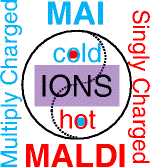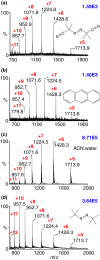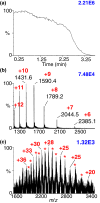"Magic" Ionization Mass Spectrometry
- PMID: 26486514
- PMCID: PMC4686549
- DOI: 10.1007/s13361-015-1253-4
"Magic" Ionization Mass Spectrometry
Abstract
The systematic study of the temperature and pressure dependence of matrix-assisted ionization (MAI) led us to the discovery of the seemingly impossible, initially explained by some reviewers as either sleight of hand or the misinterpretation by an overzealous young scientist of results reported many years before and having little utility. The “magic” that we were attempting to report was that with matrix assistance, molecules, at least as large as bovine serum albumin (66 kDa), are lifted into the gas phase as multiply charged ions simply by exposure of the matrix:analyte sample to the vacuum of a mass spectrometer. Applied heat, a laser, or voltages are not necessary to achieve charge states and ion abundances only previously observed with electrospray ionization (ESI). The fundamentals of how solid phase volatile or nonvolatile compounds are converted to gas-phase ions without added energy currently involves speculation providing a great opportunity to rethink mechanistic understanding of ionization processes used in mass spectrometry. Improved understanding of the mechanism(s) of these processes and their connection to ESI and matrix-assisted laser desorption/ionization may provide opportunities to further develop new ionization strategies for traditional and yet unforeseen applications of mass spectrometry. This Critical Insights article covers developments leading to the discovery of a seemingly magic ionization process that is simple to use, fast, sensitive, robust, and can be directly applied to surface characterization using portable or high performance mass spectrometers.
Figures








Similar articles
-
Matrix assisted ionization vacuum (MAIV), a new ionization method for biological materials analysis using mass spectrometry.Mol Cell Proteomics. 2013 Mar;12(3):792-6. doi: 10.1074/mcp.M112.023663. Epub 2012 Dec 13. Mol Cell Proteomics. 2013. PMID: 23242551 Free PMC article.
-
Toward understanding the ionization mechanism of matrix-assisted ionization using mass spectrometry experiment and theory.Rapid Commun Mass Spectrom. 2021 Jan;35 Suppl 1:e8382. doi: 10.1002/rcm.8382. Epub 2019 Mar 18. Rapid Commun Mass Spectrom. 2021. PMID: 30623523
-
Comparison of gaseous ubiquitin ion structures obtained from a solid and solution matrix using ion mobility spectrometry/mass spectrometry.Rapid Commun Mass Spectrom. 2021 Jan;35 Suppl 1:e8793. doi: 10.1002/rcm.8793. Epub 2020 Aug 20. Rapid Commun Mass Spectrom. 2021. PMID: 32220130
-
A tutorial: Laserspray ionization and related laser-based ionization methods for use in mass spectrometry.Mass Spectrom Rev. 2023 Sep-Oct;42(5):2234-2267. doi: 10.1002/mas.21762. Epub 2023 Jul 18. Mass Spectrom Rev. 2023. PMID: 37462443 Review.
-
New Processes for Ionizing Nonvolatile Compounds in Mass Spectrometry: The Road of Discovery to Current State-of-the-Art.J Am Soc Mass Spectrom. 2024 Dec 4;35(12):2753-2784. doi: 10.1021/jasms.3c00122. Epub 2024 Oct 7. J Am Soc Mass Spectrom. 2024. PMID: 39374043 Free PMC article. Review.
Cited by
-
Spontaneous Charge Separation and Sublimation Processes are Ubiquitous in Nature and in Ionization Processes in Mass Spectrometry.J Am Soc Mass Spectrom. 2018 Feb;29(2):304-315. doi: 10.1007/s13361-017-1788-7. Epub 2017 Oct 27. J Am Soc Mass Spectrom. 2018. PMID: 29080207
-
Coupling matrix-assisted ionization with high resolution mass spectrometry and electron transfer dissociation to characterize intact proteins and post-translational modifications.Anal Bioanal Chem. 2018 Jan;410(3):1007-1017. doi: 10.1007/s00216-017-0611-4. Epub 2017 Sep 12. Anal Bioanal Chem. 2018. PMID: 28900710 Free PMC article.
-
Direct sub-atmospheric pressure ionization mass spectrometry: Evaporation/sublimation-driven ionization is amazing, fundamentally, and practically.J Mass Spectrom. 2024 Jun;59(6):e5018. doi: 10.1002/jms.5018. J Mass Spectrom. 2024. PMID: 38736378 Free PMC article. Review.
-
Triboionization: a Novel Ionization Method by Peeling of Cohesive Substances for Mass Spectrometry.J Am Soc Mass Spectrom. 2019 Aug;30(8):1503-1511. doi: 10.1007/s13361-019-02220-8. Epub 2019 May 17. J Am Soc Mass Spectrom. 2019. PMID: 31102188
-
Charge-Dependent Metastable Dissociations of Multiply Charged Decafluorobiphenyl Formed by Femtosecond Laser Pulses.Mass Spectrom (Tokyo). 2023;12(1):A0130. doi: 10.5702/massspectrometry.A0130. Epub 2023 Oct 3. Mass Spectrom (Tokyo). 2023. PMID: 37799935 Free PMC article.
References
-
- Tanaka, K., Waki, H., Ido, Y., Akita, S., Yoshida, Y., Yoshida, T.: Protein and polymer analysis up to m/z 100,000 by laser ionization time-of-flight mass spectrometry. Rapid Commun. Mass Spectrom. 2, 151–153 (1988)
-
- McEwen CN, Larsen BS. Fifty years of desorption ionization of nonvolatile compounds. Int. J. Mass Spectrom. 2015;377:515–531. doi: 10.1016/j.ijms.2014.07.018. - DOI
-
- Chapman S. Carrier mobility spectra of liquids electrified by bubbling. Phys. Rev. 1938;54:520–527. doi: 10.1103/PhysRev.54.520. - DOI
Publication types
MeSH terms
Substances
LinkOut - more resources
Full Text Sources
Other Literature Sources

